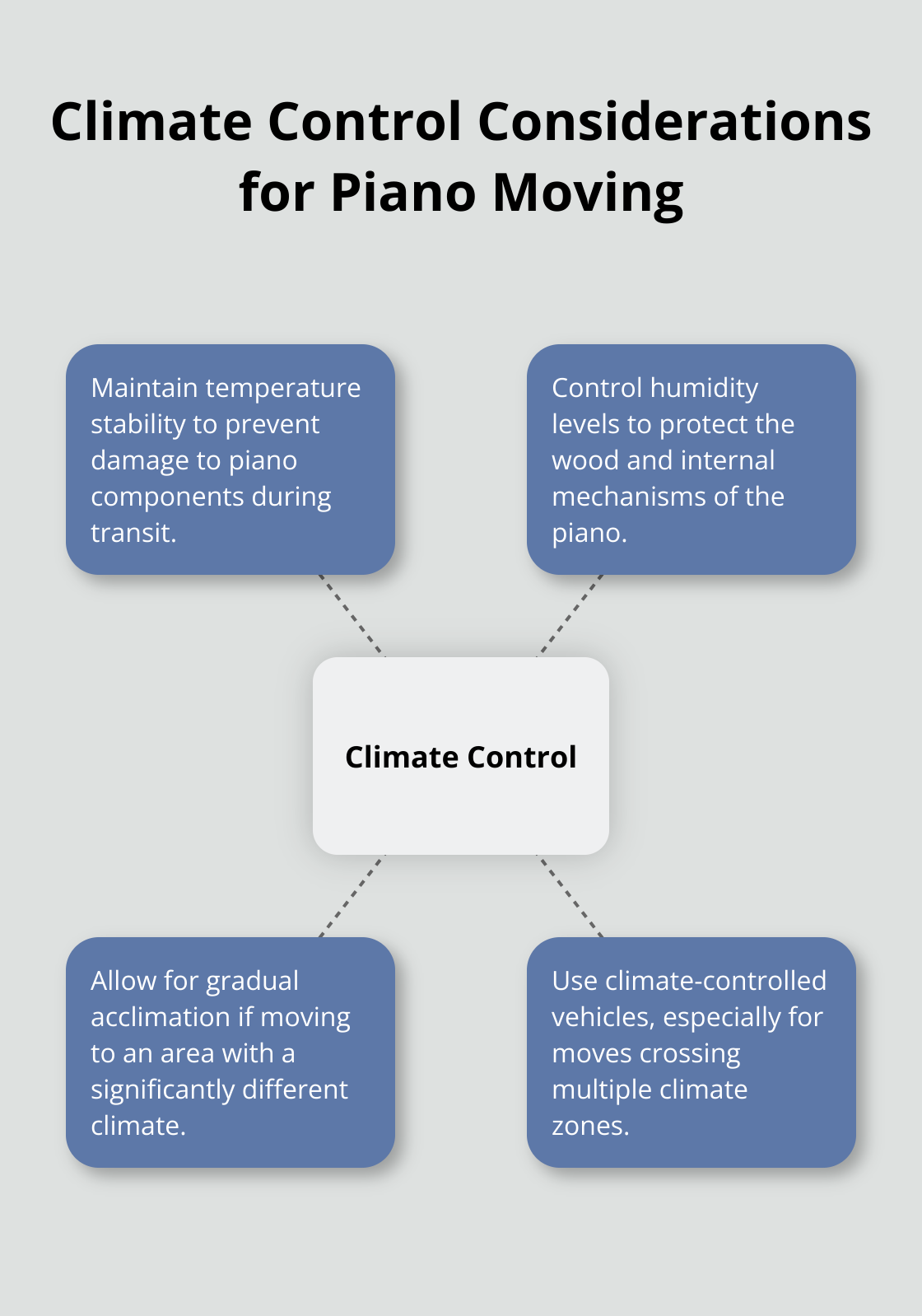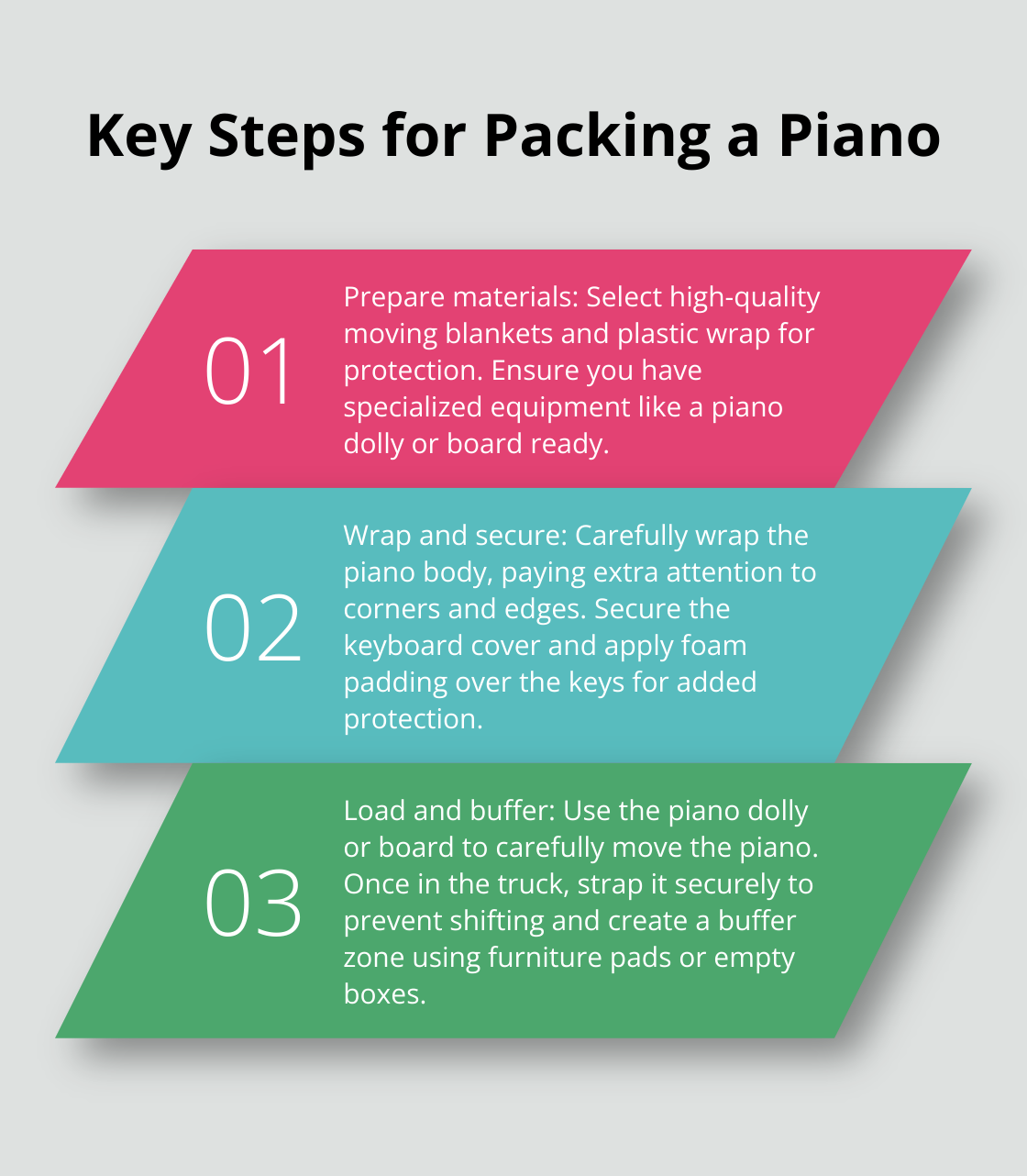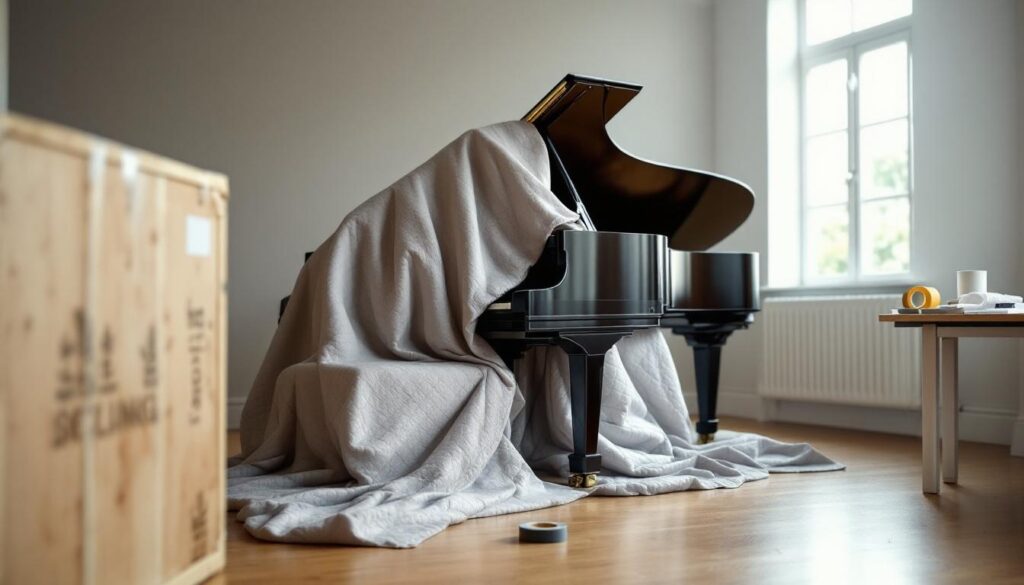Shipping a piano cross country can be a daunting task, but it’s essential to protect your valuable instrument during the journey. At Southbay Moving Systems, we understand the complexities involved in transporting these delicate and heavy instruments safely.
Our comprehensive guide will walk you through the crucial steps of preparing, packing, and choosing the right moving method for your piano. Whether you’re a professional musician or a passionate hobbyist, we’ll help you ensure your piano arrives at its destination in perfect condition.
How to Prepare Your Piano for a Cross-Country Journey
Preparing a piano for a long-distance move requires careful planning and execution. This chapter outlines the essential steps to ensure your instrument arrives safely at its destination.
Thorough Cleaning and Inspection
Start with a comprehensive cleaning of your piano. Use a soft, dry cloth to remove dust from the keys, body, and pedals. For stubborn dirt, slightly dampen the cloth with water, but avoid letting moisture seep into the piano’s internal components. This process not only protects your piano during transit but also allows for a close inspection of its current condition.
During the inspection, take detailed notes and photographs of your piano’s state. Pay attention to any scratches, dents, or other imperfections. This documentation will prove invaluable if you need to file an insurance claim later.
Secure and Pack Detachable Parts
Focus on the piano’s removable components next. Remove and pack the lid prop, music stand, and pedals separately. Wrap each piece in bubble wrap or soft moving blankets, then place them in sturdy boxes (clearly labeled with their contents).
For grand pianos, remove the legs as well. This delicate process requires professional expertise. If you attempt it yourself, consult your piano’s manual and exercise extreme caution. Once removed, wrap the legs individually and secure them in padded boxes.
Measure and Document
Accurate measurements play a vital role in planning the move. Measure the height, width, and depth of your piano, as well as its weight if possible. These details will determine the appropriate moving equipment and vehicle size needed for transport.
Don’t overlook measuring doorways, hallways, and stairwells at both your current location and the destination. This information helps identify potential obstacles and allows for proper planning of the moving route.
Climate Considerations
Pianos react sensitively to temperature and humidity changes. If you plan to move to an area with a significantly different climate, consider a gradual acclimation process for your piano before the move. This might involve adjusting your home’s temperature and humidity levels over several weeks leading up to the move.
For the actual transport, choose climate-controlled vehicles when possible (especially important for moves crossing multiple climate zones or during extreme weather conditions).

Professional Assessment
While you can complete many preparation steps yourself, a professional assessment before the move comes highly recommended. Before the actual moving day, the movers will conduct an assessment of your piano, its size, and the environment it needs to be moved through.
As we move forward to discuss choosing the right moving method, keep in mind that proper preparation sets the foundation for a successful piano relocation. The care you invest now will pay off in preserving your instrument’s quality and longevity for years to come.
How to Choose the Best Piano Moving Method
Selecting the right method for moving your piano across the country is essential for its safety and your peace of mind. Proper planning can make all the difference in a successful piano relocation.
The Professional Advantage
While DIY moving might seem cost-effective, it’s rarely the best choice for pianos. Professional piano movers bring specialized equipment and expertise that significantly reduce the risk of damage. They use piano boards, heavy-duty straps, and custom-built ramps to navigate stairs and tight spaces safely. They also have the training to disassemble and reassemble complex instruments like grand pianos without causing harm.
Climate Control: A Must-Have Feature
Temperature fluctuations can damage a piano’s delicate components. When moving across climate zones, you must insist on climate-controlled transportation. These specialized trucks maintain a consistent temperature and humidity level, protecting your piano from warping, cracking, or other climate-related damage.
The cost for climate-controlled moving typically runs 25-30% higher than standard services, but it’s a small price to pay for preserving your instrument’s integrity. Some moving companies offer this as a standard feature for piano transport.

Insurance: Your Safety Net
Standard moving insurance often falls short for high-value instruments like pianos. Most policies offer minimal coverage based on weight, which doesn’t reflect a piano’s true value. For example, a policy might only cover $0.60 per pound, leaving you vastly underinsured for an instrument worth thousands.
We recommend you purchase additional insurance specifically for your piano. Full-value protection policies are available through many moving companies or third-party insurers. These typically cost 1-2% of the declared value but provide comprehensive coverage for your peace of mind.
Timing Your Move
The time of year can impact both the cost and safety of your piano move. Summer months are peak moving season, often resulting in higher prices and less flexibility in scheduling. Winter moves in colder climates pose risks of exposure to extreme temperatures.
Spring and fall generally offer the best balance of favorable weather conditions and competitive pricing. Plan your move during these seasons if possible, and you might save 10-20% on moving costs while ensuring better conditions for your piano.
With the right moving method selected, the next step is to ensure your piano is properly packed for its journey. The following section will detail the best packing techniques to keep your instrument safe during transport.
How to Pack a Piano for Safe Transport
Selecting the Right Materials
The first step in packing a piano involves choosing appropriate materials. High-quality moving blankets are essential to protect the piano’s exterior. These blankets should be thick enough to absorb impacts and prevent scratches. For added protection, we use a layer of plastic wrap over the blankets to keep them in place and provide a barrier against moisture.
Wrapping Techniques for Different Piano Types
For upright pianos, start by wrapping the entire body, including the top, sides, and back. Pay extra attention to corners and edges, as these are prone to damage. For grand pianos, wrap each leg individually after removal. Secure the lid closed and then wrap it separately.
The keyboard cover must be locked or taped shut to prevent movement during transit. If your piano lacks a lock, pad the lid with a moving blanket or thick towel, then secure it with packing tape. Apply a layer of foam padding over the keys before wrapping the entire keyboard area.

Securing the Piano in the Moving Vehicle
Once wrapped, secure the piano properly in the moving truck. For upright pianos, use a specialized piano dolly to wheel it into position. Strap the piano tightly to the dolly and the truck’s walls using heavy-duty moving straps.
Grand pianos require a different approach. After disassembly, place the main body on its side on a piano board. Secure this board to the truck using a combination of straps and braces to prevent any shifting during transport.
Position the piano away from other items in the truck that could potentially fall or shift during transit. Create a buffer zone around the instrument using furniture pads or empty boxes to absorb any unexpected movement.
Special Considerations for Valuable Instruments
Different types of pianos require unique handling techniques. Upright pianos are generally easier to move but still require careful maneuvering through doorways and up stairs. Grand pianos, due to their size and shape, often need partial disassembly for safe transport.
For antique or particularly valuable pianos, consider custom crating. Custom crates are built to prevent the piece from shifting during transport and are lined with high-quality materials like soft foam or acid-free paper to avoid damage.
Digital pianos, while generally lighter, still require careful handling. Their electronic components are sensitive to vibrations and temperature changes. Use anti-static bubble wrap for these instruments and ensure they’re placed in a stable position in the truck.
Professional movers understand that each piano is unique and adjust packing techniques accordingly. They follow a comprehensive process that includes assessing the situation, gathering necessary equipment, enlisting professional help, preparing the piano, and using proper lifting techniques to ensure your instrument receives the specialized care it deserves during its journey.
Final Thoughts
Shipping a piano cross country requires meticulous planning and expert execution. Professional assistance proves invaluable when moving such a delicate and heavy instrument. Expert movers bring specialized equipment, knowledge, and experience that significantly reduce the risk of damage.
Proper piano transportation offers long-term benefits that extend far beyond the move itself. You preserve the instrument’s sound quality, structural integrity, and overall value through careful handling. This approach can save you from costly repairs or irreparable damage.
Southbay Moving Systems understands the unique challenges of piano relocation. Our team of experts specializes in handling pianos with the utmost care and professionalism (with over 30 years of experience in the moving industry). We offer customized solutions for both residential and commercial moves, ensuring your precious instrument receives the attention it deserves.




